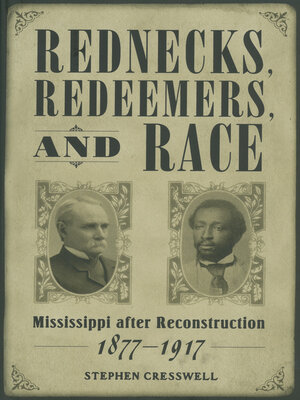Rednecks, Redeemers, and Race
ebook ∣ Mississippi after Reconstruction, 1877-1917 · Heritage of Mississippi Series
By Stephen Cresswell

Sign up to save your library
With an OverDrive account, you can save your favorite libraries for at-a-glance information about availability. Find out more about OverDrive accounts.
Find this title in Libby, the library reading app by OverDrive.



Search for a digital library with this title
Title found at these libraries:
| Library Name | Distance |
|---|---|
| Loading... |
Mississippi saw great change in the four decades after Reconstruction. Between 1877 and 1917 the state transformed. Its cities increased rapidly in size and saw the advent of electric lights, streetcars, and moving pictures. Farmers diversified their operations, sharply increasing their production of corn, sweet potatoes, and dairy products. Mississippians built large textile mills in a number of cities and increased the number of manufacturing workers tenfold.
But many things did not change. In 1917 as in 1877, Mississippi was a top cotton producer and relied more heavily on cotton than on any other product. In 1917 as in 1877 the state had troubled race relations and was all too often the site of lynchings and race riots. Compared with other states in 1917, Mississippi was near the bottom of the list for length of the school year, for percentage of farms that boasted tractors, and for the number of miles of paved or gravel roads. Mississippi was the least urban and most agricultural state in the nation.
Rednecks, Redeemers, and Race: Mississippi after Reconstruction, 1877–1917 examines the paradox of significant change alongside many unbroken continuities. It explores the reasons Mississippi was not more successful in urbanizing, in industrializing, and in reducing its reliance on cotton. The volume closes by looking at events that would move Mississippi closer to the national mainstream.
But many things did not change. In 1917 as in 1877, Mississippi was a top cotton producer and relied more heavily on cotton than on any other product. In 1917 as in 1877 the state had troubled race relations and was all too often the site of lynchings and race riots. Compared with other states in 1917, Mississippi was near the bottom of the list for length of the school year, for percentage of farms that boasted tractors, and for the number of miles of paved or gravel roads. Mississippi was the least urban and most agricultural state in the nation.
Rednecks, Redeemers, and Race: Mississippi after Reconstruction, 1877–1917 examines the paradox of significant change alongside many unbroken continuities. It explores the reasons Mississippi was not more successful in urbanizing, in industrializing, and in reducing its reliance on cotton. The volume closes by looking at events that would move Mississippi closer to the national mainstream.







